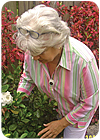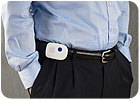
The CareGard system from GE Security, Bradenton, Fla., includes personal emergency response system (PERS) buttons in pendants or as wristbands.

Home health monitoring systems have gone beyond the simple buttons on pendants or wrists seniors push to call for assistance when they fall. These systems, called personal emergency response systems (PERS), are being used by individuals with limited mobility and are a good first step in making the smart home savvy about health care. They are considered entry-level compared with a second tier of products.
These more sophisticated systems use sensors throughout the home to monitor a resident’s daily routine and report to a family member, health monitoring central station, or both when a significant variance is noted.
If the person needing assistance cannot reach his or her emergency call button or loses consciousness, these systems note the variation in routine and report it even if the person cannot.
A third type of health device is used by residents to monitor their health needs. They can determine heart rate, oxygen saturation, blood pressure, peak flow for asthmatics, glucose levels for diabetics, and aid with dispensing of medicines. These can be used by any home control customer who has a medical condition that could be aided by the device.
ADT, Boca Raton, Fla., provides these devices to customers to help them anticipate potential episodes with their existing health problems, such as diabetes, asthma, high blood pressure and others, and to help insurance programs keep their costs lower.

Alarms from health monitoring systems can be received by cell phone.
The home monitoring device ADT offers its customers is called QuietCare. It is designed for seniors and people with disabilities that affect their mobility. Supplied to ADT by a company called the Living Independently Group Inc., New York, it also is sold to independent dealers.
“Our phones are ringing every day across the spectrum, from alarm companies wanting to rep the product,” reports Robin McVey, president and COO of the Living Independently Group. “I think the most successful dealers, in my opinion, will be dealers that have touched the senior market in some shape, form or fashion, that know and have marketed to and have worked with the senior market.”
McVey recommends using a good, better, best strategy to sell PERS by itself, QuietCare by itself or the two combined. “Our customers love to have both these products together,” McVey insists. “PERS has been out there a long time.
“Unfortunately, many of the customers don’t wear the pendants, or put them in a drawer and forget them,” he maintains. “If they do fall or need some help, it becomes a difficult situation versus QuietCare, where they don’t have to wear anything. The motion sensor just learns their activities of daily living, and if there is a deviation of the norm, that’s when alerts are sent. They forget all about it.”
Monitoring is handled by any of four companies that have met the Living Independently Group’s qualifications. “They have to go through quite a bit to become an approved monitoring company with us,” McVey declares.
Home monitoring systems also are being used by single women or families with young teenagers or that employ babysitters who may need assistance when they are supervising children by themselves.
“The majority of our calls are non-emergency calls for some type of daily assistance,” reveals Eric O’Connor, president of Alert One Services Inc., Williamsport, Pa. “We believe that giving people the ability to clearly communicate with someone is key to their independence.”
The company’s ClearCall device can be worn on a belt or a pendant around the neck, but instead of only sending a signal to a monitoring center, it provides two-way voice communication with one of Alert One’s three monitoring centers.
“We anticipate this product being one of the first revolutions in our industry in more than 30 years,” O’Connor declares. “We think this device is going to absolutely change our industry.”

The QuietCare system from Living Independently Group, New York, consists of tubular motion sensors that report back wirelessly to a base station on the activities of a home’s resident.
SOME HOME INTEGRATION INCLUDED
ClearCall can answer telephone calls through its pendant, or on models without that feature, the base station turns into a speakerphone.“It is a fabulous feature that a lot of people love and enjoy,” O’Connor enthuses. “It’s with all our devices, not only with ClearCall. ClearCall is the only one you can talk into the pendant device you’re wearing.”
Some integration of home control with health care monitoring is included with the CareGard system from GE Security, Bradenton, Fla. It uses X-10 technology that communicates through a home’s electrical power lines to flash lights when the health monitoring system’s alarm is pressed by a resident. This flashing can help first responders to locate the home.
“We are also finding dealers that are taking existing security alarm control panels and adding additional features to those panels utilizing GE products to emulate a CareGard unit,” reveals Kirk MacDowell, GE Security’s residential marketing leader. “It will not give you all the same features as a standalone unit, but it will come pretty close. The advantage of installing it with the burglar alarm system is that the consumer does not have to have two devices in the home.”

The HomMed Genesis monitor from Honeywell HomMed LLC, Brookfield, Wis., provides information on a resident’s blood pressure, glucose level, temperature and other vital signs.
“We tweak our existing security sensors to look for activity, and we tweak them to look for no activity,” MacDowell explains. “The same sensors can detect intrusion or movement by a person. Our dealers do that all the time — they program the sensor differently, whether it is a perimeter door or window. It’s almost the opposite of detecting a burglar.”
Door and window sensors also are used and can be put on interior doors or even those on medicine cabinets. These can be combined with PERS buttons that subscribers can wear as wristwatches or pendants.
“So rather than getting an alert when a sensor activates, you set up a schedule that if the sensors do not activate on a certain day, that’s a bad sign,” explains Alison Slavin, vice president of product management for Alarm.com, McLean, Va.
GE Security uses Alarm.com to provide automatic response services for its health monitoring system. Alarm.com’s operations center receives all alarms from GE units and relays them to central stations or owners on the basis of criteria set up by the dealer/integrators for their customers.

Two-way voice communication is provided by ClearCall from Alert One Services Inc., Williamsport, Pa. It can be worn on a belt or a pendant around the neck.
REVENUE GENERATOR
Another company that offers health monitoring is SafetyCare Technologies LLC, Reading, Pa., which recently was acquired by TeleAlarm LLC, a manufacturer, marketer and servicer of wireless emergency call systems for medical alert monitoring.SafetyCare had been selling TeleAlarm’s Caveo 872 PERS device, points out Mike Bodnar, SafetyCare Technologies’ general manager. “It is a great fit,” he declares.
SafetyCare is in the final stages of a $2 million renovation to the company’s existing central station in Reading that Bodnar anticipates will streamline the company’s monitoring capabilities.
“It can be sold by dealers who have or don’t have their own central stations,” Bodnar says about SafetyCare’s products.
Bodnar sees home health monitoring as an overlay to home control. MacDowell agrees. “A lot of dealers look at it as a tremendous revenue-producing market,” he says about home medical monitoring. “Dealers are adding on between $15 to 20 additional per month over their standard monitoring rate.
“As a standalone unit, the RMR tends to be a little more expensive, from $34.95/month to $45/month,” MacDowell estimates. “Some dealers are just mailing it out, giving customers the 800 number and walking them through on the phone how to set it up.”
But McVey does not recommend that approach. “A live person should do the installation for the person, walk them through it, ask any questions and make sure they are completely satisfied before they leave the house,” McVey insists. “That is a very critical piece of the puzzle for us.”
Alert One provides its products either way. “The installation and the customer evaluation is a good opportunity to come in and assist somebody with the total service, and how they can get them prepared for that total service,” O’Connor suggests.
Sidebar: Health Monitoring Association Working on Issues
The newly-formed Medical Alert Monitoring Association (MAMA) is working on federal funding to help individuals afford personal medical monitoring.It also is exploring recruiting an official insurance carrier for members, providing educational sessions and speakers, and possibly providing marketing support for members, reports president Ken Gross, who also is president of Connect America Medical Alarm Co., Brookmall, Pa.
MAMA held an annual meeting March 28 at the ISC West in Las Vegas. Currently, officers and board members are focusing on building the base membership of the association through mailings, announcements on its Web site, personal phone calls and word of mouth.
In addition to individuals and companies providing personal emergency response systems (PERS) and medical monitoring equipment, manufacturers and central stations are encouraged to become members of the association. For more information, visitwww.medicalalertmonitoringassociation.com.
—By Maggie McFadden, Managing Editor


